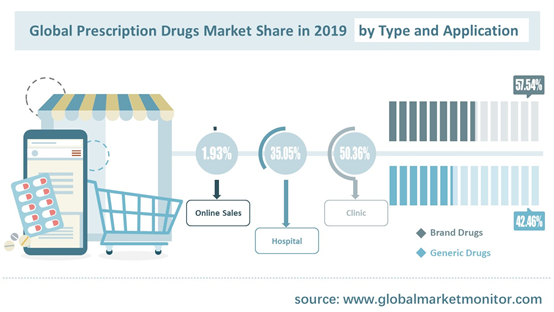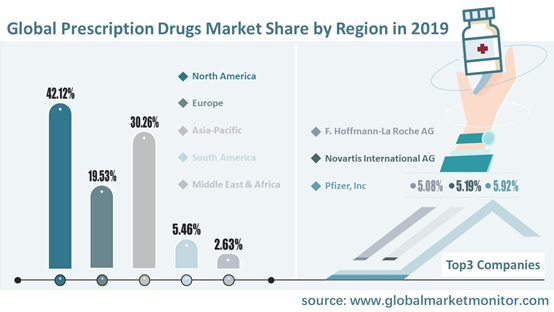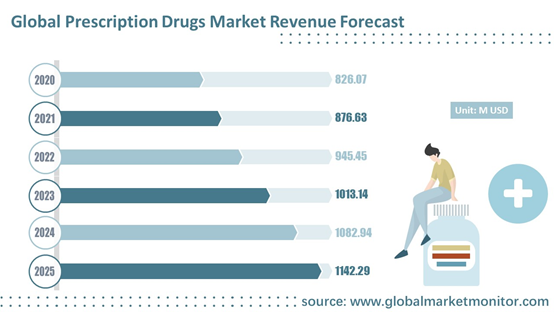Prescription drugs refer to prescriptions issued by doctors who have the right to prescribe, and drugs purchased from hospitals or pharmacies. This drug usually has some toxicity and other potential effects. There are special requirements for the medication method and time, and it must be used under the guidance of a doctor.
There are currently two main types of prescription drugs in the world: brand drugs and generic drugs. Brand drugs are sold under specific brands by the company that produces the drug (usually the company that develops the drug and obtains a patent). When the patent expires, other companies sell copies of these drugs at a lower cost, that is, generic drugs, whose dosage, intended use, effect, side effects, route of administration, risk, safety and strength are exactly the same as the original drug. New drug approval in the United States can be said to be the most stringent and standard in the world. The FDA (U.S. Food and Drug Administration) requires generic drugs to be as safe and effective as brand drugs. However, in terms of excipients and manufacturing processes, it is difficult for generic drugs to be the same as the original drugs. Although the prices of generic drugs are lower, the public still trusts brand drugs more, so the brand drugs market is broader, with a market share of 57.54% in 2019. In recent years, the public acceptance of generic drugs has gradually increased, so the global demand for generic drugs is increasing. It is estimated that the market share of generic drugs will increase from 43.52% in 2020 to 47.83% in 2025.

In life, due to prescription restrictions, most people buy prescription drugs through hospitals and clinics. In 2019, their market shares were 35.05% and 50.36%, respectively. In fact, in addition to these medical institutions, prescription drugs are still sold online. However, there are still many problems in the safety supervision of online prescription drugs, so they have been restricted for many years. In 2019, the market share was only 1.93%.
Analysis of the Status Quo of Prescription Drug Industry in Various Regions
North America is the largest revenue market, with a market share of 43.23% in 2015 and a market share of 42.12% in 2019, a decrease of 1.11%. The Asia-Pacific region and Europe ranked second and third with 30.26% and 19.53% market shares in 2019. South America, the Middle East and Africa have relatively low levels of economic development, low levels of medical and health care, and relatively small markets.
Get the Complete Sample, Please Click: https://www.globalmarketmonitor.com/reports/762522-prescription-drugs-market-report.html

The Asia-Pacific region has the largest population in the world and provides a huge consumer base for the prescription drug industry. The developing countries in the Asia-Pacific region, dominated by China and India, have experienced strong economic growth in recent years, their living standards have improved, and medical health has continued to improve. In addition, the increasingly serious aging has increased the demand for this industry, so the Asia-Pacific region is expected to become the fastest growing region, with a market share of 30.77% by 2025.
As far as the current development of prescription drugs in various regions is concerned, the market is mainly affected by economic development and national policies. Most countries in the world have implemented a classification management system for prescription drugs and over-the-counter drugs, strictly stipulating that prescription drugs must not be advertised to the public. Currently, the United States and New Zealand are the only countries in the world that allow pharmaceutical companies to sell prescription drugs directly to consumers. In the 1980s, the US Food and Drug Administration relaxed restrictions on prescription drug advertising, greatly reducing the description of drug safety risks or side effects, which is beneficial to the development of the pharmaceutical industry. To this day, the pharmaceutical industry is still investing billions of dollars in TV and print advertising campaigns.
Most of the companies in this industry come from North America. The top three companies in 2019, Hoffmann-La Roche AG, Novartis International AG and Pfizer, Inc accounted for market share of 5.92%, 5.19% and 5.08%, respectively.
Online Sales Will Become a New Growth Point of Prescription Drug Industry
In 2020, the prescription drug industry was hit by COVID-19, affecting its production and sales, with a market growth rate of -3.73%. During this period, prescription drug companies stopped production and there was a short-term supply shortage. With the spread of the international epidemic, international transportation, especially sea transportation, has been greatly restricted, causing difficulties in logistics and transportation, resulting in a decline in the export volume of APIs and a lower than normal level of capacity utilization. The epidemic has also forced the government, experts and pharmaceutical companies to focus on medicines related to the epidemic, and non-epidemic medical needs have been suspended. After the resumption of work and production, non-anti-epidemic medical needs may break out in the short term.

In 2015, the global prescription drug market revenue was 730.35 million U.S. dollars, and by 2020 it will increase to 826.07 million U.S. dollars. With the development of the economy, the improvement of consumption power, and the improvement of medical policies, there is a huge demand for prescription drugs in the market. In addition, the increasing aging of the population in various countries has played an important role in promoting the growth of the prescription drug market. Therefore, we predict that the global prescription drug industry market value will reach 1142.29 billion US dollars by 2025.
In recent years, the e-commerce industry has developed rapidly, driving the growth of the online prescription drug market. Online sales of prescription drugs have brought convenience for consumers to buy drugs, which are also in line with modern fast-paced lifestyles. As pharmacy platforms become more standardized, personal awareness of online purchase of prescription drugs will increase. Online sales of prescription drugs will increase from 2.18% in 2020 to 5.07% in 2025, becoming a new growth point for the industry. Therefore, companies in the industry should keep up with the times, standardize systems and improve drug quality while promoting online sales, so as to promote their own sustainable development.
Get the Complete Sample, Please Click: https://www.globalmarketmonitor.com/reports/762522-prescription-drugs-market-report.htmlWe provide more professional and intelligent market reports to complement your business decisions.